fuel VOLKSWAGEN TIGUAN 2017 OwnerВґs Manual
[x] Cancel search | Manufacturer: VOLKSWAGEN, Model Year: 2017, Model line: TIGUAN, Model: VOLKSWAGEN TIGUAN 2017Pages: 341, PDF Size: 9.14 MB
Page 4 of 341
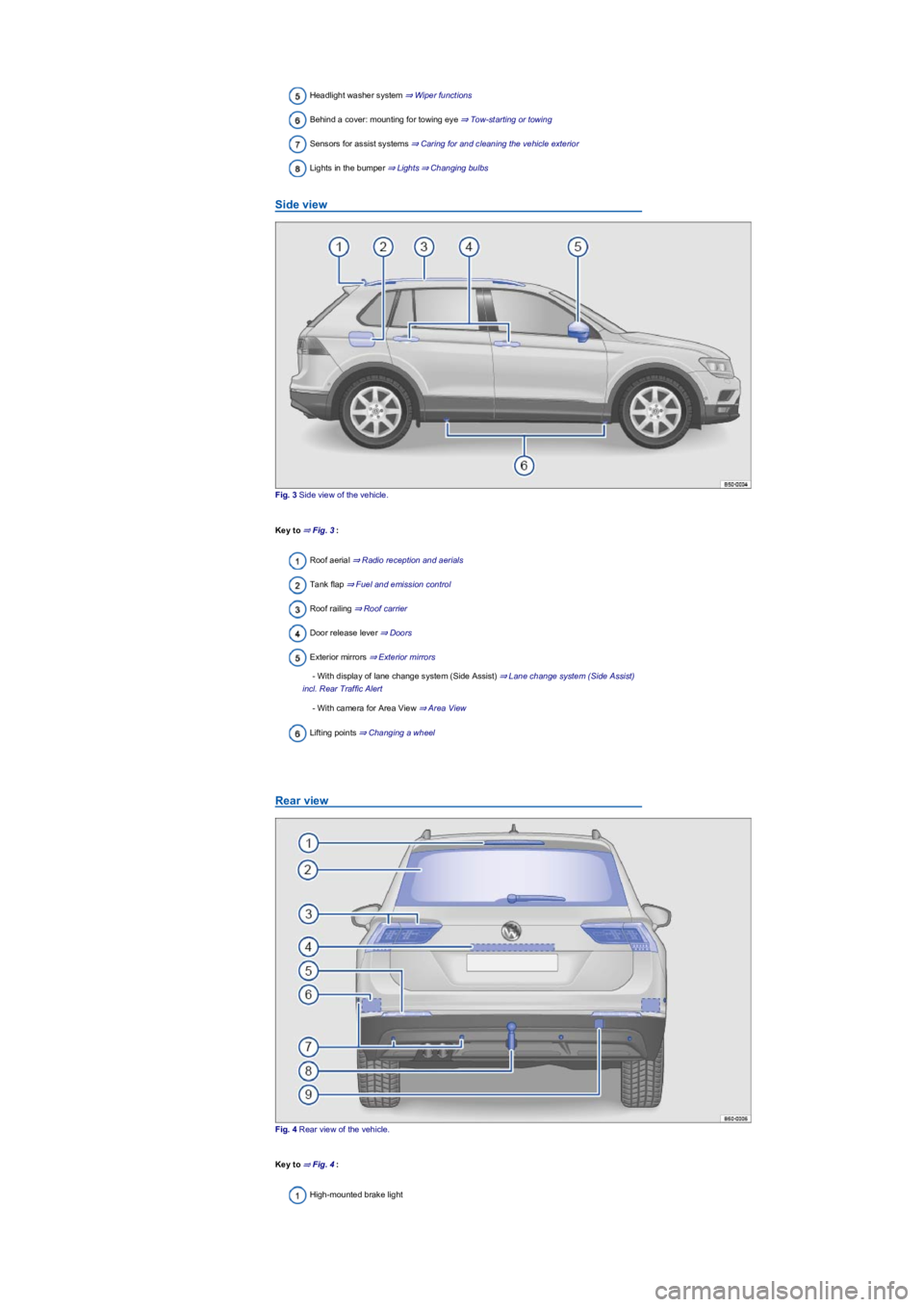
Headlight washer system в‡’В WiperВ functions
Behind a cover: mounting for towing eye в‡’В Tow-startingВ orВ towing
Sensors for assist systems в‡’В CaringВ forВ andВ cleaningВ theВ vehicleВ exterior
Lights in the bumper ⇒ Lights⇒ Changing bulbs
Side view
Fig. 3 Side view of the vehicle.
Key to в‡’В Fig.В 3:
Roof aerial в‡’В RadioВ receptionВ andВ aerials
Tank flap в‡’В FuelВ andВ emissionВ control
Roof railing в‡’В RoofВ carrier
Door release lever в‡’В Doors
Exterior mirrors в‡’В ExteriorВ mirrors
- With display of lane change system (Side Assist) в‡’В LaneВ changeВ systemВ (SideВ Assist)В
incl.В RearВ TrafficВ Alert
- With camera for Area View в‡’В AreaВ View
Lifting points в‡’В ChangingВ aВ wheel
Rear view
Fig. 4 Rear view of the vehicle.
Key to в‡’В Fig.В 4:
High-mounted brake light
Page 10 of 341

Depending on the vehicle equipment level, symbols may be displayed in the instrument cluster
instead of warning lamps.
Some warning and indicator lamps are not available in all markets.
For details on indicator lamps which light up in the light switch, see Chapter Lights в‡’В Lights.
SymbolMeaning
Central warning lamp. Observe the additional information on the
instrument cluster display.
Do not drive on!
The electronic parking brake is switched on в‡’В ElectronicВ parkingВ
brake.
Do not drive on!
Brake fluid level too low or fault in the brake system в‡’В BrakeВ fluid.
Do not drive on!
Coolant level too low в‡’В EngineВ coolant, engine coolant temperature
too high or fault in the cooling system в‡’В CoolantВ temperatureВ display.
Do not drive on!
Engine oil pressure too low в‡’В EngineВ oil.
Flashing: Do not drive on! Fault in the electronic steering column
lock в‡’В Steering.
Lit up: electromechanical steering has failed в‡’В Steering.
Driver or front passenger seat belt not fastened в‡’В SeatВ belts.
OR: there are objects on the front passenger seat в‡’В SeatВ belts.
Brake or take evasive action.
Collision warning from area monitoring system (Front Assist) в‡’В AreaВ
monitoringВ systemВ (FrontВ Assist).
OR: collision warning from Pedestrian Monitoring в‡’В PedestrianВ
Monitoring.
Depress the brake pedal. в‡’В DSGВ dualВ clutchВ gearbox, в‡’В AdaptiveВ
CruiseВ ControlВ (ACC).
Fault in the alternator в‡’В 12-voltВ vehicleВ battery.
Front brake pads worn. Go to a qualified workshop immediately. All
brake pads should be checked and renewed as necessary
в‡’В InformationВ onВ theВ brakes.
Central warning lamp. Observe the additional information on the
instrument cluster display.
Electronic Stability Control (ESC) в‡’В BrakeВ supportВ systems.
Traction control system (TCS) в‡’В BrakeВ supportВ systems.
OR: off-road driving profile active в‡’В DrivingВ profileВ selectionВ andВ
4MOTIONВ ActiveВ Control.
Anti-lock brake system faulty or not functioning в‡’В BrakeВ supportВ
systems.
Electronic parking brake fault в‡’В ElectronicВ parkingВ brake.
Rear fog light switched on в‡’В Lights.
Partial or complete failure of the vehicle lighting, excluding cornering
light в‡’В ChangingВ bulbs.
Lit up: there is a fault that affects the exhaust emissions
в‡’В Troubleshooting.
Flashing: misfiring, which damages the catalytic converter
в‡’В Troubleshooting.
Engine management system fault (Electronic Power Control)
в‡’В Troubleshooting.
Engine speed limited (protection against overheating)
в‡’В Troubleshooting.
Lit up: electromechanical steering reduced
OR: the 12-volt battery has been disconnected and reconnected
в‡’В Steering.
Flashing: steering column is wound-up or is not unlocked/locked
в‡’В Steering.
Lit up: tyre pressure too low в‡’В TyreВ monitoringВ systems.
Flashing: fault in tyre monitoring system в‡’В TyreВ monitoringВ systems.
Fault in the rain/light sensor в‡’В Wipers.
Fault in wipers в‡’В Wipers.
Washer fluid level too low в‡’В Wipers.
Fuel tank almost empty в‡’В FuelВ gauge.
Lit up: engine oil level too low в‡’В EngineВ oil.
Flashing: engine oil system fault в‡’В EngineВ oil.
В®
Page 12 of 341

SymbolMeaning
WhenВ displayedВ inВ grey: Off-road driving profile not active. System
switched on, but not regulating в‡’В DrivingВ profileВ selectionВ andВ
4MOTIONВ ActiveВ Control.
Additional displays: diesel vehicles
SymbolMeaning
The engine cannot be restarted! AdBlue fill level is too low
в‡’В EmissionВ controlВ withВ AdBlue.
The engine cannot be restarted! Fault in the selective catalytic
reduction system в‡’В EmissionВ controlВ withВ AdBlue.
Water in fuel in vehicles with a diesel engine в‡’В FuelВ gauge.
Lit up: diesel engine is preheating before starting в‡’В StartingВ andВ
stoppingВ theВ engine.
Flashing: fault in engine management system (diesel engine)
в‡’В Troubleshooting.
Diesel particulate filter has become saturated with soot
в‡’В Troubleshooting.
AdBlue level is low в‡’В EmissionВ controlВ withВ AdBlue.
Selective catalytic reduction system faulty or not refilled using norm-
standard AdBlue⇒ Emission control with AdBlue.
Instrument cluster
Introduction
This chapter contains information on the followingsubjects:
в‡’В AnalogueВ instrumentВ cluster
в‡’В DigitalВ instrumentВ clusterВ (ActiveВ InfoВ Display)
в‡’В Head-upВ Display
в‡’В Displays
в‡’В InstrumentВ clusterВ menus
в‡’В DrivingВ dataВ displayВ (multifunctionВ display)
в‡’В WarningВ andВ informationВ messages
в‡’В DriverВ AlertВ SystemВ (recommendationВ forВ restВ breaks)
в‡’В DynamicВ RoadВ SignВ DisplayВ (SignВ Assist)
в‡’В Time
в‡’В FuelВ gauge
в‡’В CoolantВ temperatureВ display
в‡’В ServiceВ intervalВ display
The vehicle is equipped either with an analogue or a digital instrument cluster (Active Info Display).
When you start the engine after the 12-volt battery has been totally discharged or changed, you
may find that system settings (time, date, personal convenience settings and programming) have
been changed or deleted. Check and correct the settings as necessary once the 12-volt vehicle
battery has been sufficiently charged.
Analogue instrument cluster
В®
В®
В®
®®
®®
Failure to observe illuminated warning lamps and text messages can lead to your vehicle
breaking down in traffic, and can cause accidents and serious injury.
•Never ignore any illuminated warning lamps or text messages.
•Stop the vehicle as soon as possible and when safe to do so.
WARNING
Accidents and injuries can occur if the driver is distracted.
•Never press the buttons on the instrument cluster while the vehicle is in motion.
•Any settings for the instrument cluster display and displays in the Infotainment system
should be made only when the vehicle is stationary in order to reduce the risk of
accidents and serious injuries.
WARNING
Page 13 of 341
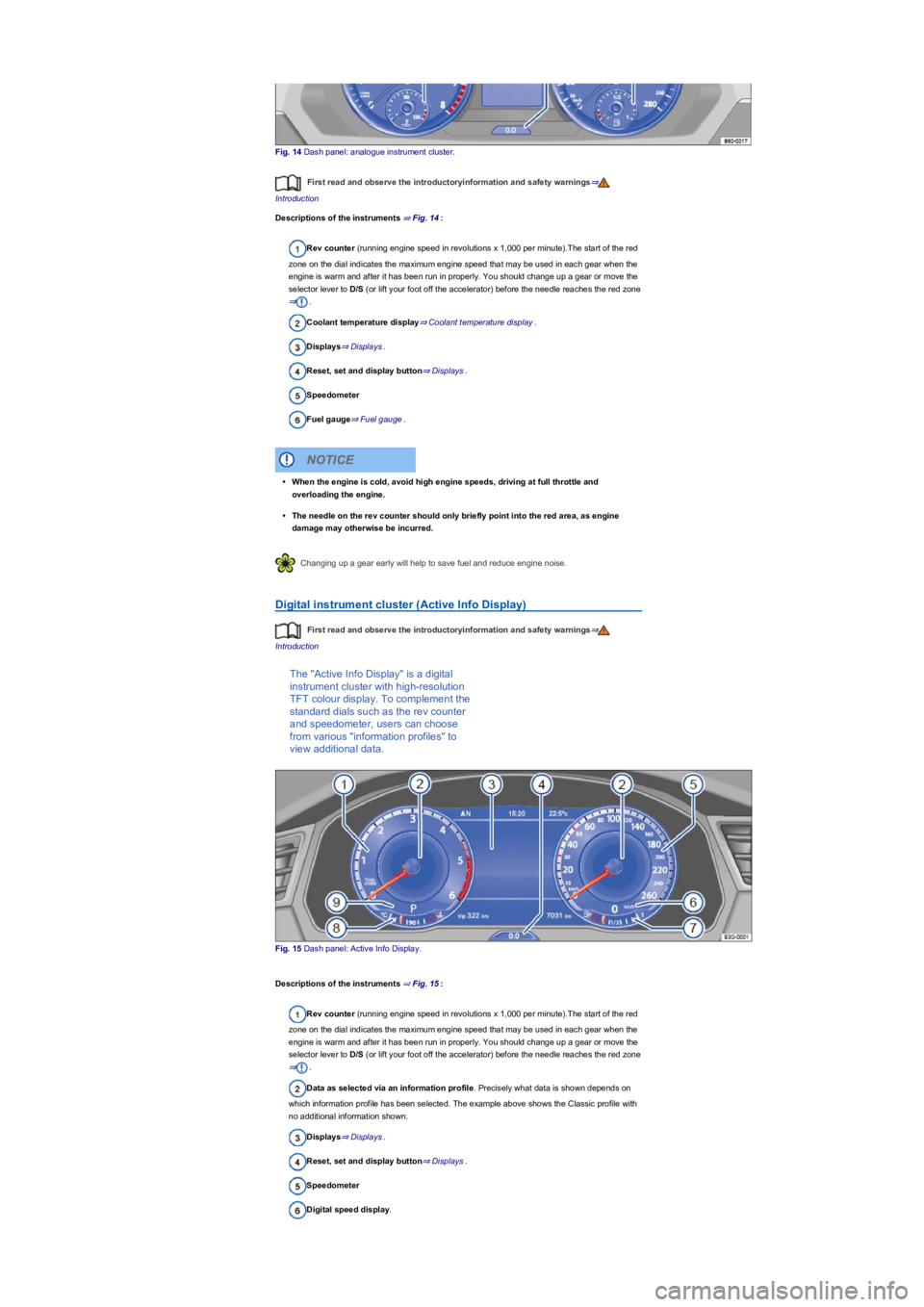
Fig. 14 Dash panel: analogue instrument cluster.
First read and observe the introductoryinformation and safety warnings⇒
Introduction
Descriptions of the instruments в‡’В Fig.В 14:
Rev counter (running engine speed in revolutions x 1,000 per minute).The start of the red
zone on the dial indicates the maximum engine speed that may be used in each gear when the
engine is warm and after it has been run in properly. You should change up a gear or move the
selector lever to D/S (or lift your foot off the accelerator) before the needle reaches the red zone
в‡’.
Coolant temperature display⇒ Coolant temperature display.
Displays⇒ Displays.
Reset, set and display button⇒ Displays.
Speedometer
Fuel gauge⇒ Fuel gauge.
Changing up a gear early will help to save fuel and reduce engine noise.
Digital instrument cluster (Active Info Display)
First read and observe the introductoryinformation and safety warnings⇒
Introduction
The "Active Info Display" is a digital
instrument cluster with high-resolution
TFT colour display. To complement the
standard dials such as the rev counter
and speedometer, users can choose
from various "information profiles" to
view additional data.
Fig. 15 Dash panel: Active Info Display.
Descriptions of the instruments в‡’В Fig.В 15:
Rev counter (running engine speed in revolutions x 1,000 per minute).The start of the red
zone on the dial indicates the maximum engine speed that may be used in each gear when the
engine is warm and after it has been run in properly. You should change up a gear or move the
selector lever to D/S (or lift your foot off the accelerator) before the needle reaches the red zone
в‡’.
Data as selected via an information profile. Precisely what data is shown depends on
which information profile has been selected. The example above shows the Classic profile with
no additional information shown.
Displays⇒ Displays.
Reset, set and display button⇒ Displays.
Speedometer
Digital speed display.
•When the engine is cold, avoid high engine speeds, driving at full throttle and
overloading the engine.
•The needle on the rev counter should only briefly point into the red area, as engine
damage may otherwise be incurred.
NOTICE
Page 14 of 341
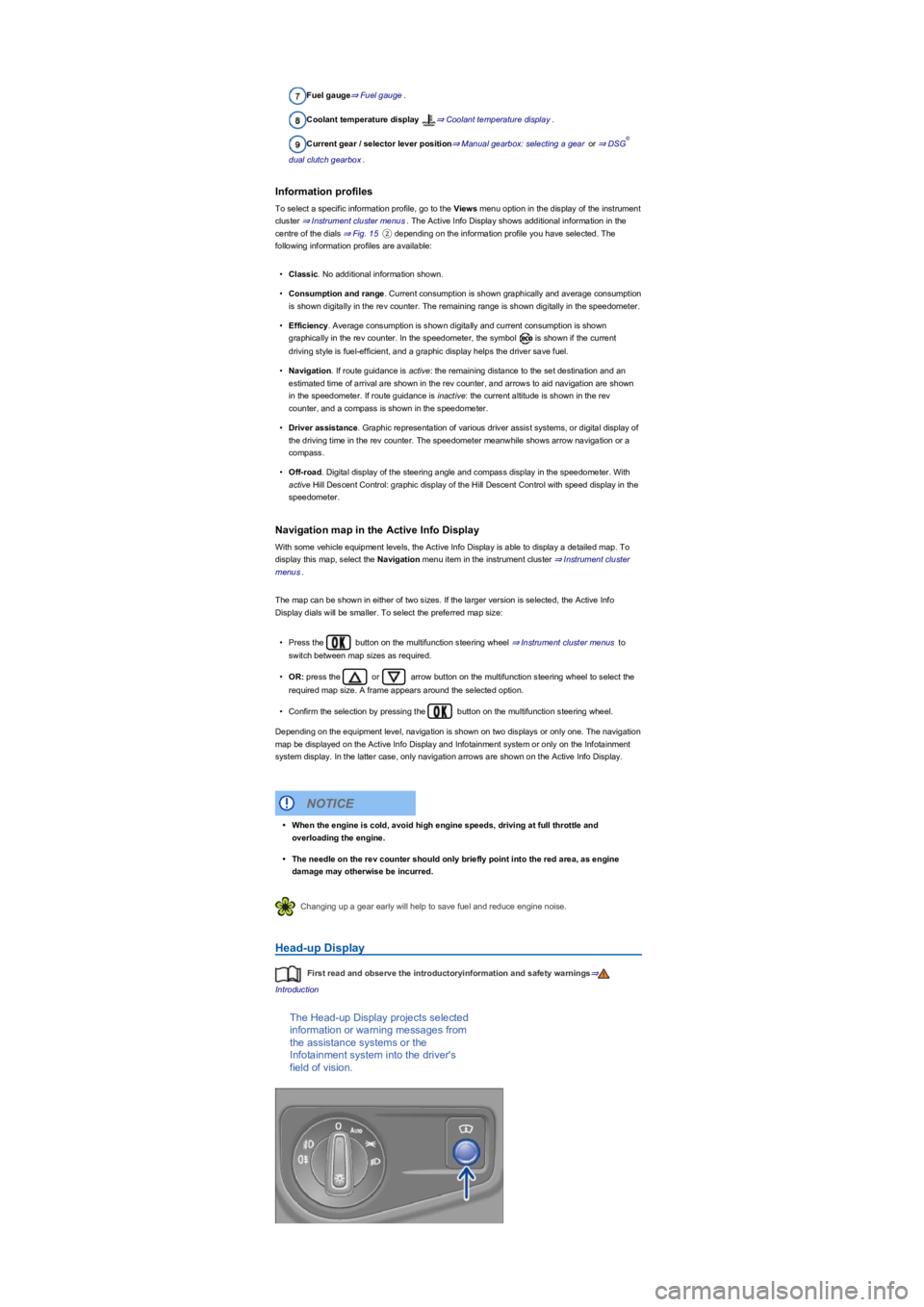
Fuel gauge⇒ Fuel gauge.
Coolant temperature display в‡’В CoolantВ temperatureВ display.
Current gear / selector lever position⇒ Manual gearbox: selecting a gear or ⇒ DSG
dualВ clutchВ gearbox.
Information profiles
To select a specific information profile, go to the Views menu option in the display of the instrument
cluster в‡’В InstrumentВ clusterВ menus. The Active Info Display shows additional information in the
centre of the dials в‡’В Fig.В 15в‘Ў depending on the information profile you have selected. The
following information profiles are available:
•Classic. No additional information shown.
•Consumption and range. Current consumption is shown graphically and average consumption
is shown digitally in the rev counter. The remaining range is shown digitally in the speedometer.
•Efficiency. Average consumption is shown digitally and current consumption is shown
graphically in the rev counter. In the speedometer, the symbol is shown if the current
driving style is fuel-efficient, and a graphic display helps the driver save fuel.
•Navigation. If route guidance is active: the remaining distance to the set destination and an
estimated time of arrival are shown in the rev counter, and arrows to aid navigation are shown
in the speedometer. If route guidance is inactive: the current altitude is shown in the rev
counter, and a compass is shown in the speedometer.
•Driver assistance. Graphic representation of various driver assist systems, or digital display of
the driving time in the rev counter. The speedometer meanwhile shows arrow navigation or a
compass.
•Off-road. Digital display of the steering angle and compass display in the speedometer. With
active Hill Descent Control: graphic display of the Hill Descent Control with speed display in the
speedometer.
Navigation map in the Active Info Display
With some vehicle equipment levels, the Active Info Display is able to display a detailed map. To
display this map, select the Navigation menu item in the instrument cluster в‡’В InstrumentВ clusterВ
menus.
The map can be shown in either of two sizes. If the larger version is selected, the Active Info
Display dials will be smaller. To select the preferred map size:
•Press the button on the multifunction steering wheel ⇒ Instrument cluster menus to
switch between map sizes as required.
•OR: press the or arrow button on the multifunction steering wheel to select the
required map size. A frame appears around the selected option.
•Confirm the selection by pressing the button on the multifunction steering wheel.
Depending on the equipment level, navigation is shown on two displays or only one. The navigation
map be displayed on the Active Info Display and Infotainment system or only on the Infotainment
system display. In the latter case, only navigation arrows are shown on the Active Info Display.
Changing up a gear early will help to save fuel and reduce engine noise.
Head-up Display
First read and observe the introductoryinformation and safety warnings⇒
Introduction
The Head-up Display projects selected
information or warning messages from
the assistance systems or the
Infotainment system into the driver's
field of vision.
В®
•When the engine is cold, avoid high engine speeds, driving at full throttle and
overloading the engine.
•The needle on the rev counter should only briefly point into the red area, as engine
damage may otherwise be incurred.
NOTICE
Page 16 of 341
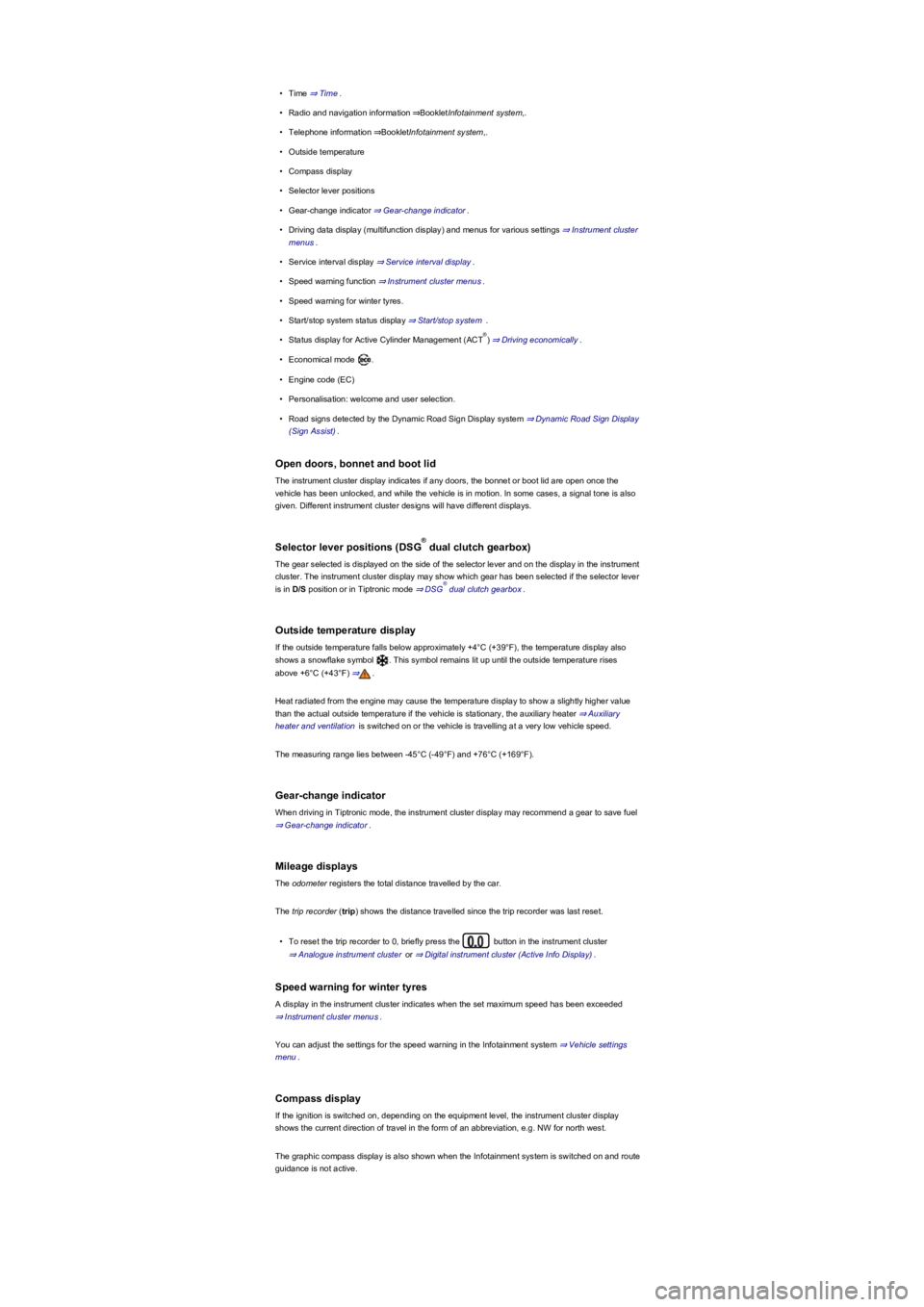
•Time ⇒ Time.
•Radio and navigation information ⇒BookletInfotainment system,.
•Telephone information ⇒BookletInfotainment system,.
•Outside temperature
•Compass display
•Selector lever positions
•Gear-change indicator ⇒ Gear-change indicator.
•Driving data display (multifunction display) and menus for various settings в‡’В InstrumentВ clusterВ
menus.
•Service interval display ⇒ Service interval display.
•Speed warning function ⇒ Instrument cluster menus.
•Speed warning for winter tyres.
•Start/stop system status display ⇒ Start/stop system .
•Status display for Active Cylinder Management (ACT) ⇒ Driving economically.
•Economical mode .
•Engine code (EC)
•Personalisation: welcome and user selection.
•Road signs detected by the Dynamic Road Sign Display system в‡’В DynamicВ RoadВ SignВ DisplayВ
(SignВ Assist).
Open doors, bonnet and boot lid
The instrument cluster display indicates if any doors, the bonnet or boot lid are open once the
vehicle has been unlocked, and while the vehicle is in motion. In some cases, a signal tone is also
given. Different instrument cluster designs will have different displays.
Selector lever positions (DSG dual clutch gearbox)
The gear selected is displayed on the side of the selector lever and on the display in the instrument
cluster. The instrument cluster display may show which gear has been selected if the selector lever
is in D/S position or in Tiptronic mode в‡’В DSGВ dualВ clutchВ gearbox.
Outside temperature display
If the outside temperature falls below approximately +4В°C (+39В°F), the temperature display also
shows a snowflake symbol . This symbol remains lit up until the outside temperature rises
above +6В°C (+43В°F) в‡’.
Heat radiated from the engine may cause the temperature display to show a slightly higher value
than the actual outside temperature if the vehicle is stationary, the auxiliary heater в‡’В AuxiliaryВ
heaterВ andВ ventilation is switched on or the vehicle is travelling at a very low vehicle speed.
The measuring range lies between -45В°C (-49В°F) and +76В°C (+169В°F).
Gear-change indicator
When driving in Tiptronic mode, the instrument cluster display may recommend a gear to save fuel
в‡’В Gear-changeВ indicator.
Mileage displays
The odometer registers the total distance travelled by the car.
The tripВ recorder (trip) shows the distance travelled since the trip recorder was last reset.
•To reset the trip recorder to 0, briefly press the button in the instrument cluster
в‡’В AnalogueВ instrumentВ cluster or в‡’В DigitalВ instrumentВ clusterВ (ActiveВ InfoВ Display).
Speed warning for winter tyres
A display in the instrument cluster indicates when the set maximum speed has been exceeded
в‡’В InstrumentВ clusterВ menus.
You can adjust the settings for the speed warning in the Infotainment system в‡’В VehicleВ settingsВ
menu.
Compass display
If the ignition is switched on, depending on the equipment level, the instrument cluster display
shows the current direction of travel in the form of an abbreviation, e.g. NW for north west.
The graphic compass display is also shown when the Infotainment system is switched on and route
guidance is not active.
В®
В®
В®
Page 17 of 341
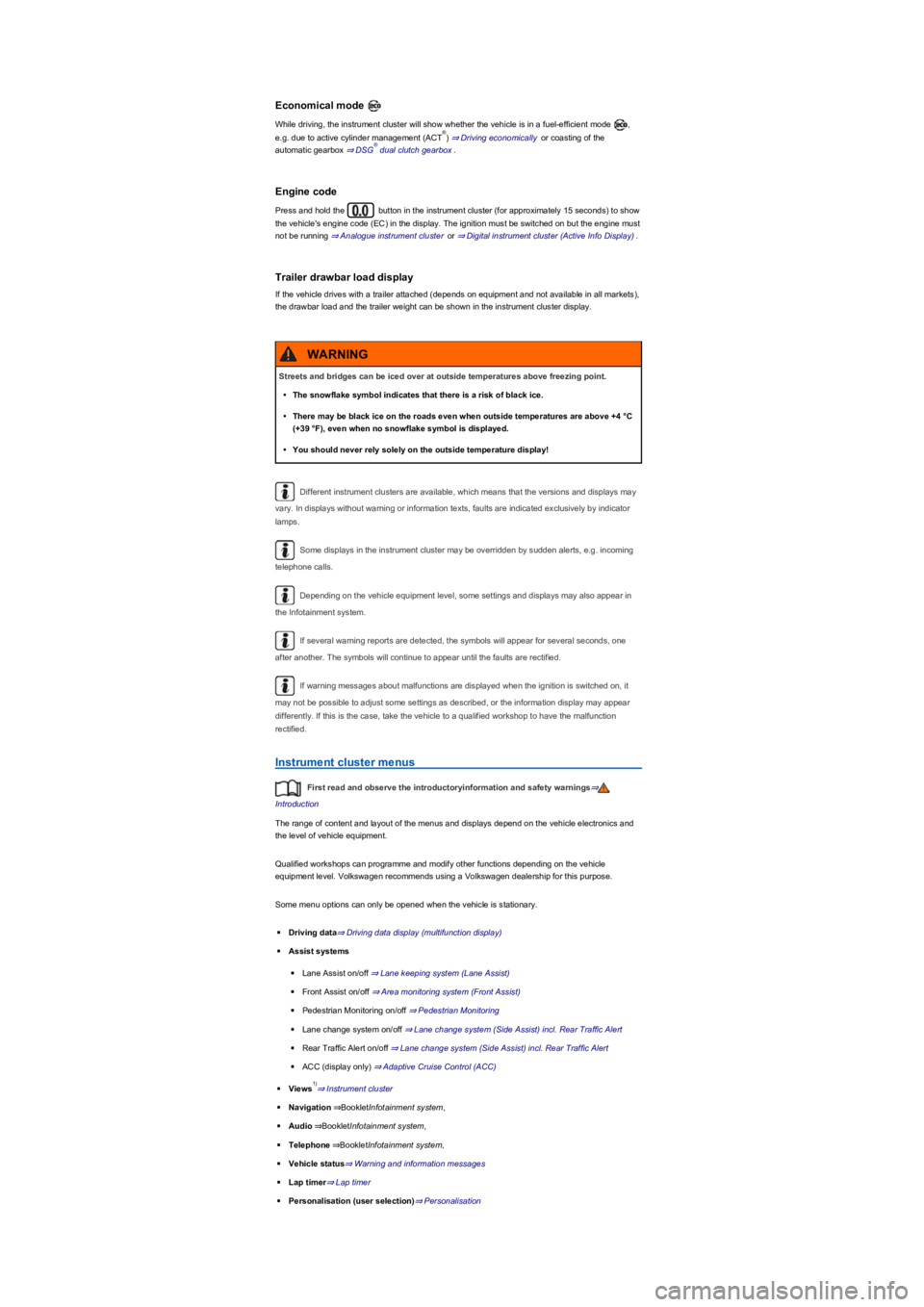
Economical mode
While driving, the instrument cluster will show whether the vehicle is in a fuel-efficient mode ,
e.g. due to active cylinder management (ACT) в‡’В DrivingВ economically or coasting of the
automatic gearbox в‡’В DSGВ dualВ clutchВ gearbox.
Engine code
Press and hold the button in the instrument cluster (for approximately 15 seconds) to show
the vehicle's engine code (EC) in the display. The ignition must be switched on but the engine must
not be running в‡’В AnalogueВ instrumentВ cluster or в‡’В DigitalВ instrumentВ clusterВ (ActiveВ InfoВ Display).
Trailer drawbar load display
If the vehicle drives with a trailer attached (depends on equipment and not available in all markets),
the drawbar load and the trailer weight can be shown in the instrument cluster display.
Different instrument clusters are available, which means that the versions and displays may
vary. In displays without warning or information texts, faults are indicated exclusively by indicator
lamps.
Some displays in the instrument cluster may be overridden by sudden alerts, e.g. incoming
telephone calls.
Depending on the vehicle equipment level, some settings and displays may also appear in
the Infotainment system.
If several warning reports are detected, the symbols will appear for several seconds, one
after another. The symbols will continue to appear until the faults are rectified.
If warning messages about malfunctions are displayed when the ignition is switched on, it
may not be possible to adjust some settings as described, or the information display may appear
differently. If this is the case, take the vehicle to a qualified workshop to have the malfunction
rectified.
Instrument cluster menus
First read and observe the introductoryinformation and safety warnings⇒
Introduction
The range of content and layout of the menus and displays depend on the vehicle electronics and
the level of vehicle equipment.
Qualified workshops can programme and modify other functions depending on the vehicle
equipment level. Volkswagen recommends using a Volkswagen dealership for this purpose.
Some menu options can only be opened when the vehicle is stationary.
◾Driving data⇒ Driving data display (multifunction display)
в—ѕAssist systems
в—ѕLane Assist on/off в‡’В LaneВ keepingВ systemВ (LaneВ Assist)
в—ѕFront Assist on/off в‡’В AreaВ monitoringВ systemВ (FrontВ Assist)
в—ѕPedestrian Monitoring on/off в‡’В PedestrianВ Monitoring
в—ѕLane change system on/off в‡’В LaneВ changeВ systemВ (SideВ Assist)В incl.В RearВ TrafficВ Alert
в—ѕRear Traffic Alert on/off в‡’В LaneВ changeВ systemВ (SideВ Assist)В incl.В RearВ TrafficВ Alert
в—ѕACC (display only) в‡’В AdaptiveВ CruiseВ ControlВ (ACC)
◾Views⇒ Instrument cluster
◾Navigation⇒BookletInfotainment system,
◾Audio⇒BookletInfotainment system,
◾Telephone⇒BookletInfotainment system,
◾Vehicle status⇒ Warning and information messages
◾Lap timer⇒ Lap timer
в—ѕPersonalisation (user selection)в‡’В Personalisation
В®
В®
Streets and bridges can be iced over at outside temperatures above freezing point.
•The snowflake symbol indicates that there is a risk of black ice.
•There may be black ice on the roads even when outside temperatures are above +4 °C
(+39 В°F), even when no snowflake symbol is displayed.
•You should never rely solely on the outside temperature display!
WARNING
1)
Page 18 of 341
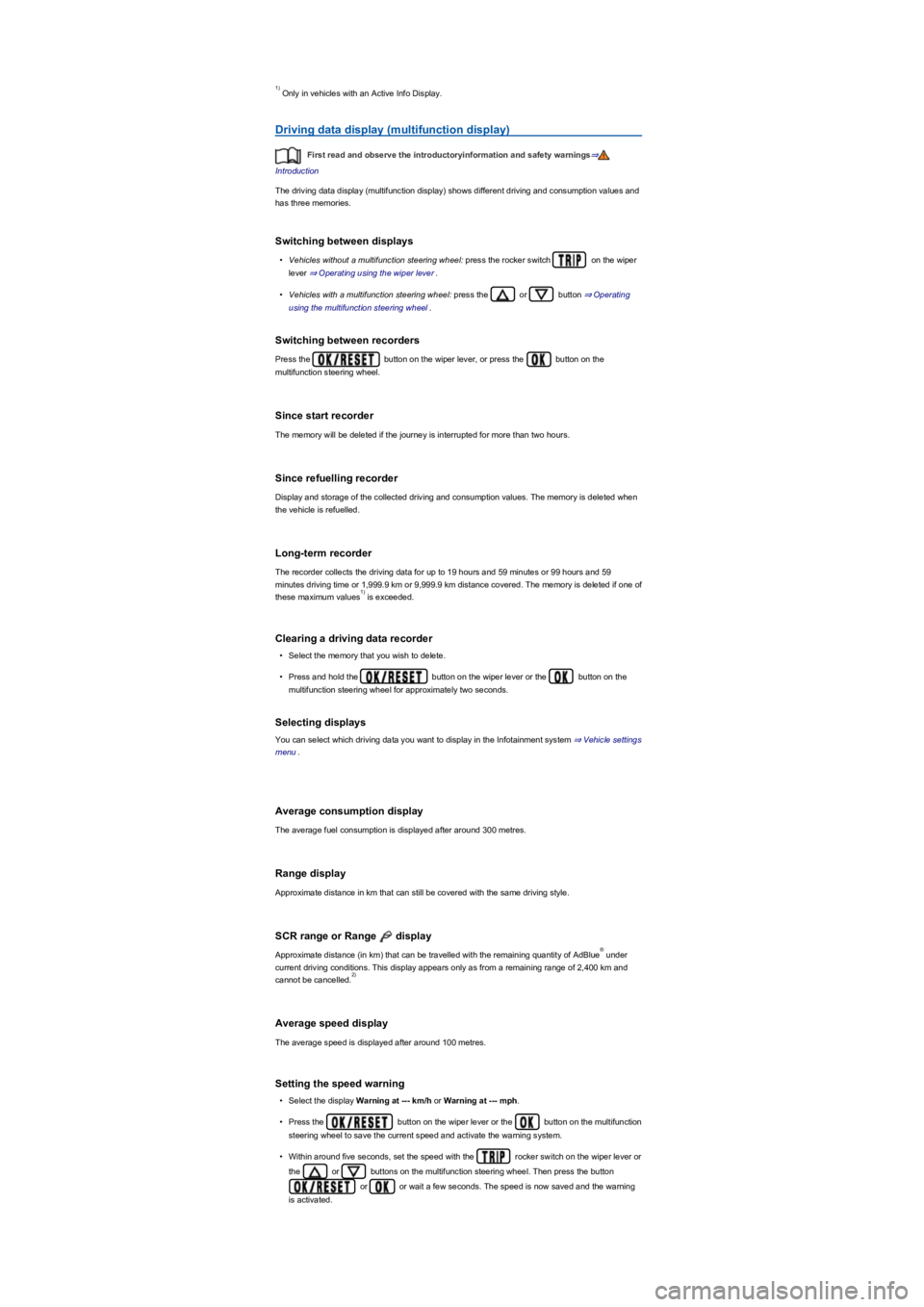
Only in vehicles with an Active Info Display.
Driving data display (multifunction display)
First read and observe the introductoryinformation and safety warnings⇒
Introduction
The driving data display (multifunction display) shows different driving and consumption values and
has three memories.
Switching between displays
•Vehicles without a multifunction steering wheel: press the rocker switch on the wiper
lever в‡’В OperatingВ usingВ theВ wiperВ lever.
•VehiclesВ withВ aВ multifunctionВ steeringВ wheel: press the or button в‡’В OperatingВ
usingВ theВ multifunctionВ steeringВ wheel.
Switching between recorders
Press the button on the wiper lever, or press the button on the
multifunction steering wheel.
Since start recorder
The memory will be deleted if the journey is interrupted for more than two hours.
Since refuelling recorder
Display and storage of the collected driving and consumption values. The memory is deleted when
the vehicle is refuelled.
Long-term recorder
The recorder collects the driving data for up to 19 hours and 59 minutes or 99 hours and 59
minutes driving time or 1,999.9 km or 9,999.9 km distance covered. The memory is deleted if one of
these maximum values is exceeded.
Clearing a driving data recorder
•Select the memory that you wish to delete.
•Press and hold the button on the wiper lever or the button on the
multifunction steering wheel for approximately two seconds.
Selecting displays
You can select which driving data you want to display in the Infotainment system в‡’В VehicleВ settingsВ
menu.
Average consumption display
The average fuel consumption is displayed after around 300 metres.
Range display
Approximate distance in km that can still be covered with the same driving style.
SCR range or Range display
Approximate distance (in km) that can be travelled with the remaining quantity of AdBlue under
current driving conditions. This display appears only as from a remaining range of 2,400 km and
cannot be cancelled.
Average speed display
The average speed is displayed after around 100 metres.
Setting the speed warning
•Select the display Warning at --- km/h or Warning at --- mph.
•Press the button on the wiper lever or the button on the multifunction
steering wheel to save the current speed and activate the warning system.
•Within around five seconds, set the speed with the rocker switch on the wiper lever or
the or buttons on the multifunction steering wheel. Then press the button
or or wait a few seconds. The speed is now saved and the warning
is activated.
1)
1)
В®
2)
Page 23 of 341
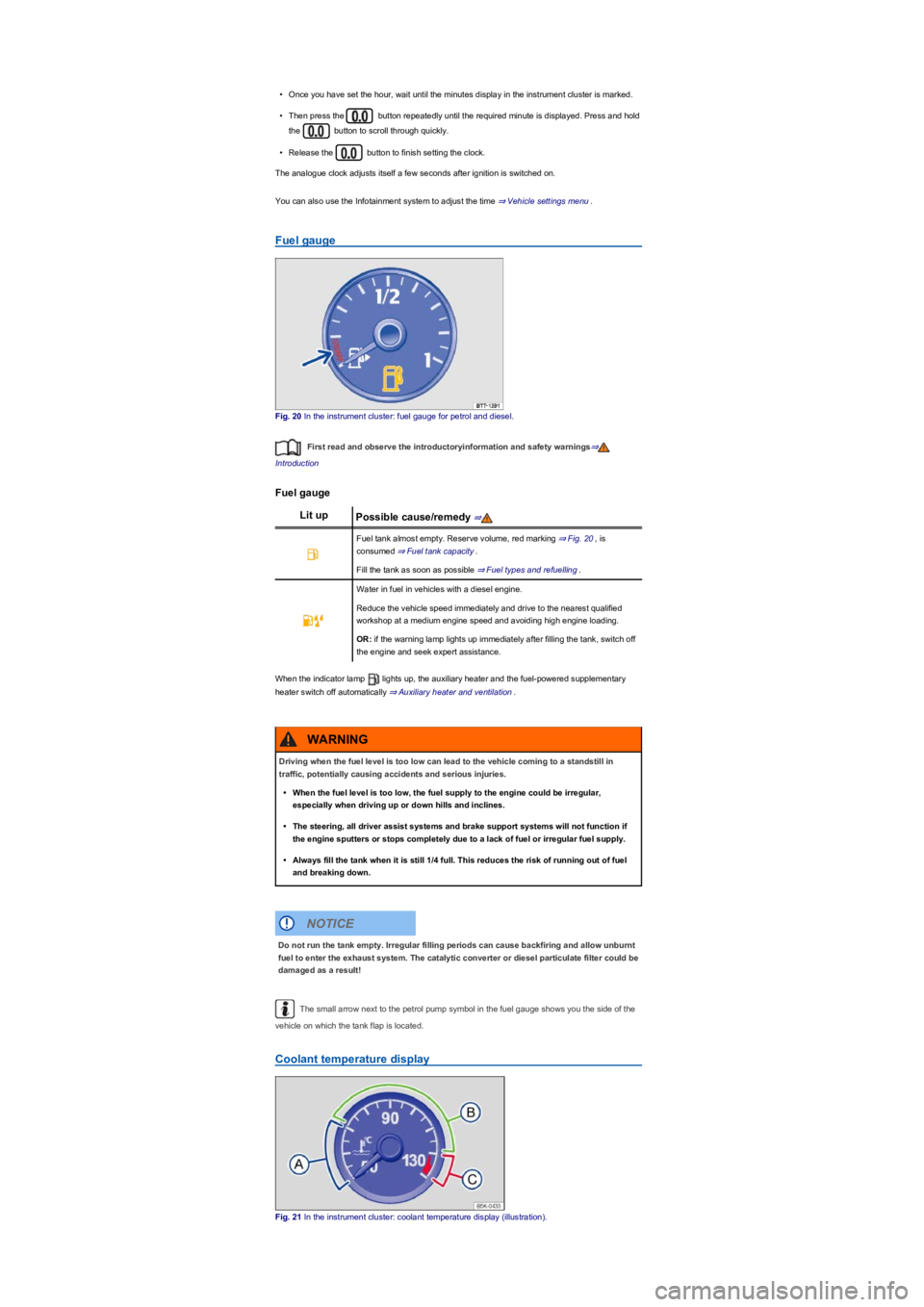
•Once you have set the hour, wait until the minutes display in the instrument cluster is marked.
•Then press the button repeatedly until the required minute is displayed. Press and hold
the button to scroll through quickly.
•Release the button to finish setting the clock.
The analogue clock adjusts itself a few seconds after ignition is switched on.
You can also use the Infotainment system to adjust the time в‡’В VehicleВ settingsВ menu.
Fuel gauge
Fig. 20 In the instrument cluster: fuel gauge for petrol and diesel.
First read and observe the introductoryinformation and safety warnings⇒
Introduction
Fuel gauge
Lit upPossible cause/remedy в‡’
Fuel tank almost empty. Reserve volume, red marking в‡’В Fig.В 20, is
consumed в‡’В FuelВ tankВ capacity.
Fill the tank as soon as possible в‡’В FuelВ typesВ andВ refuelling.
Water in fuel in vehicles with a diesel engine.
Reduce the vehicle speed immediately and drive to the nearest qualified
workshop at a medium engine speed and avoiding high engine loading.
OR: if the warning lamp lights up immediately after filling the tank, switch off
the engine and seek expert assistance.
When the indicator lamp lights up, the auxiliary heater and the fuel-powered supplementary
heater switch off automatically в‡’В AuxiliaryВ heaterВ andВ ventilation.
The small arrow next to the petrol pump symbol in the fuel gauge shows you the side of the
vehicle on which the tank flap is located.
Coolant temperature display
Fig. 21 In the instrument cluster: coolant temperature display (illustration).
Driving when the fuel level is too low can lead to the vehicle coming to a standstill in
traffic, potentially causing accidents and serious injuries.
•When the fuel level is too low, the fuel supply to the engine could be irregular,
especially when driving up or down hills and inclines.
•The steering, all driver assist systems and brake support systems will not function if
the engine sputters or stops completely due to a lack of fuel or irregular fuel supply.
•Always fill the tank when it is still 1/4 full. This reduces the risk of running out of fuel
and breaking down.
WARNING
Do not run the tank empty. Irregular filling periods can cause backfiring and allow unburnt
fuel to enter the exhaust system. The catalytic converter or diesel particulate filter could be
damaged as a result!
NOTICE
Page 30 of 341
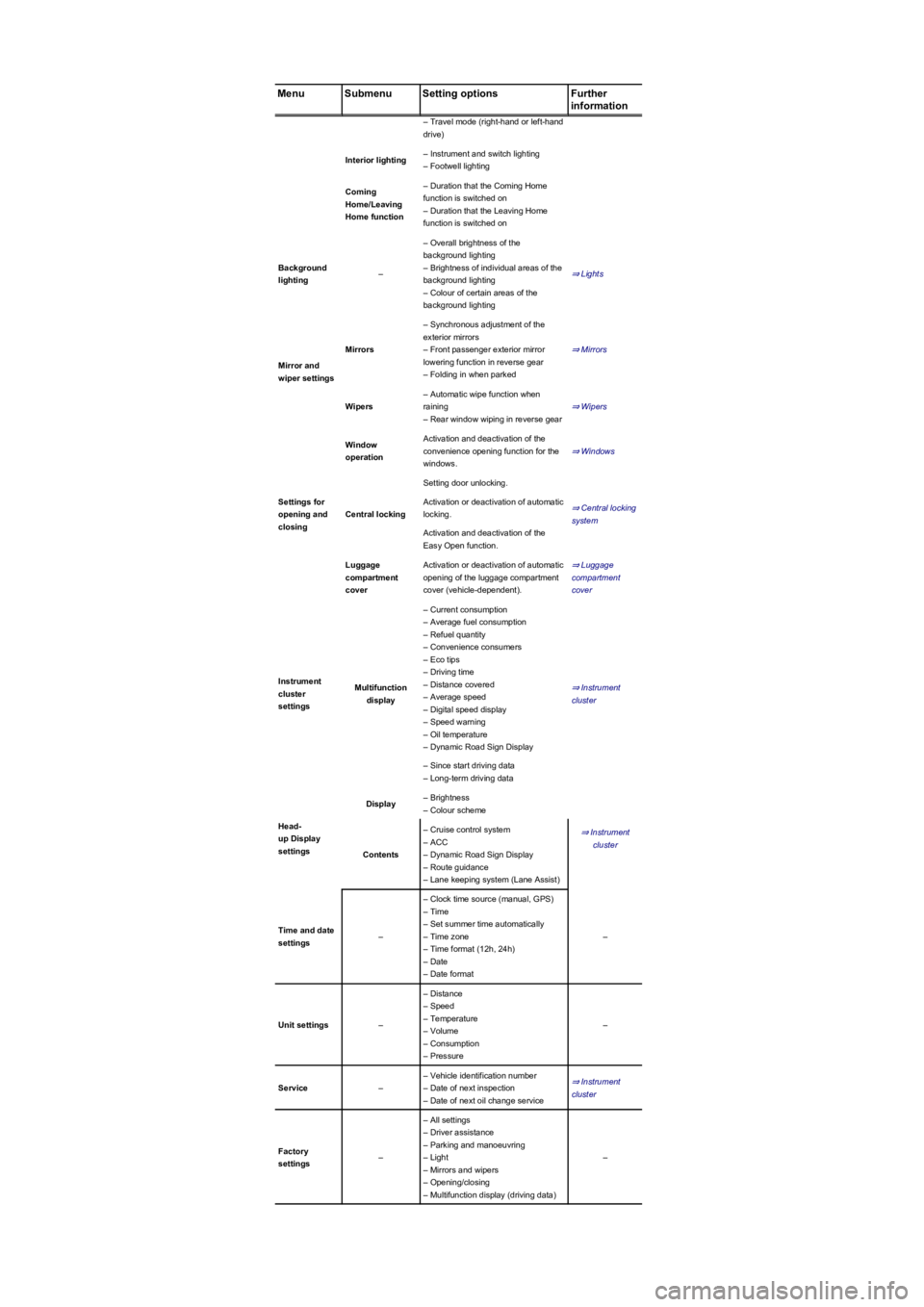
MenuSubmenuSetting optionsFurther
information
– Travel mode (right-hand or left-hand
drive)
Interior lighting– Instrument and switch lighting
– Footwell lighting
Coming
Home/Leaving
Home function
– Duration that the Coming Home
function is switched on
– Duration that the Leaving Home
function is switched on
Background
lighting–
– Overall brightness of the
background lighting
– Brightness of individual areas of the
background lighting
– Colour of certain areas of the
background lighting
в‡’В Lights
Mirror and
wiper settings
Mirrors
– Synchronous adjustment of the
exterior mirrors
– Front passenger exterior mirror
lowering function in reverse gear
– Folding in when parked
в‡’В Mirrors
Wipers
– Automatic wipe function when
raining
– Rear window wiping in reverse gear
в‡’В Wipers
Settings for
opening and
closing
Window
operation
Activation and deactivation of the
convenience opening function for the
windows.
в‡’В Windows
Central locking
Setting door unlocking.
в‡’В CentralВ lockingВ
system
Activation or deactivation of automatic
locking.
Activation and deactivation of the
Easy Open function.
Luggage
compartment
cover
Activation or deactivation of automatic
opening of the luggage compartment
cover (vehicle-dependent).
в‡’В LuggageВ
compartmentВ
cover
Instrument
cluster
settings
Multifunction
display
– Current consumption
– Average fuel consumption
– Refuel quantity
– Convenience consumers
– Eco tips
– Driving time
– Distance covered
– Average speed
– Digital speed display
– Speed warning
– Oil temperature
– Dynamic Road Sign Display
в‡’В InstrumentВ
cluster
– Since start driving data
– Long-term driving data
Head-
up Display
settings
Display– Brightness
– Colour scheme
в‡’В InstrumentВ
cluster
Contents
– Cruise control system
– ACC
– Dynamic Road Sign Display
– Route guidance
– Lane keeping system (Lane Assist)
Time and date
settings–
– Clock time source (manual, GPS)
– Time
– Set summer time automatically
– Time zone
– Time format (12h, 24h)
– Date
– Date format
–
Unit settings–
– Distance
– Speed
– Temperature
– Volume
– Consumption
– Pressure
–
Service–
– Vehicle identification number
– Date of next inspection
– Date of next oil change service
в‡’В InstrumentВ
cluster
Factory
settings–
– All settings
– Driver assistance
– Parking and manoeuvring
– Light
– Mirrors and wipers
– Opening/closing
– Multifunction display (driving data)
–